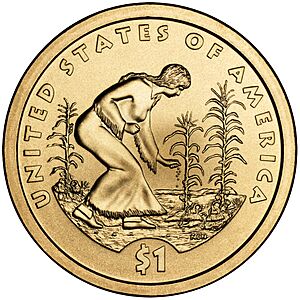Three Sisters (agriculture) facts for kids
The Three Sisters are three important crops grown together by many Indigenous groups in North America. These crops are winter squash, maize (corn), and climbing beans. They first came from Mesoamerica (parts of Central America and Mexico). Over many years, these crops traveled north along river valleys. Groups like the Mandan and Iroquois used the "Three Sisters" for food and for trading with others.
Contents
How the Three Sisters Grow Together
This special way of planting is called companion planting. The three crops are planted very close to each other. Farmers build flat-topped mounds of soil for each group of plants. Each mound is about 30 cm (12 inches) high and 50 cm (20 inches) wide. Several corn seeds are planted close together in the middle of each mound.
In some areas, like the Atlantic Northeast, people buried rotten fish or eels with the corn seeds. This helped to fertilize the soil, especially if it was poor. When the corn plants grew to about 15 cm (6 inches) tall, beans and squash were planted around them. The farmers would plant bean seeds and squash seeds one after another.
It took a very long time for people to learn this farming method. This knowledge developed over 5,000 to 6,500 years! Squash was the first crop to be grown by people on purpose. This happened about 8,000 to 10,000 years ago. Corn was next, and then beans.
How Each Sister Helps the Others
The three crops help each other grow strong.
- Corn provides a tall stalk for the beans to climb. This means farmers do not need to use poles.
- Beans add nitrogen to the soil. Nitrogen is a nutrient that other plants need to grow.
- Squash spreads out along the ground. Its large leaves block the sunlight, which helps stop weeds from growing. The squash leaves also act like a "living mulch". This keeps the soil moist and cool. The tiny, prickly hairs on the squash vines also help keep away pests.
Together, corn, beans, and squash are a very healthy meal. They contain important nutrients like carbohydrates, healthy fats, and all the essential amino acids your body needs.
Three Sisters Gardens Across North America
Native Americans all over North America grew different versions of Three Sisters gardens. In Mesoamerica, large farms or gardens using companion planting were called milpas. The Ancestral Puebloans also used this garden design. They even used it in dry areas.
The Tewa people and others in the North American Southwest sometimes added a "fourth Sister." This was a plant called Rocky Mountain bee plant (Cleome serrulata). This plant attracts bees, which helps pollinate the beans and squash.
The Three Sisters planting method is shown on the back of the 2009 US Sacagawea dollar coin.
Three Sisters and Ancient Cultures
Cahokia and Mississippian Culture
Corn, squash, and beans were planted around 800 AD in Cahokia. This was the largest Native American city north of the Rio Grande. Cahokia was located in what is now Illinois, near St. Louis, Missouri. The Three Sisters crops produced a lot of extra food. This allowed more people to live in the Mississippi River valley. This led to the growth of the Mississippian and Mvskoke cultures. These cultures thrived from about 800 CE to 1600 CE. Around 1600, Spanish explorers arrived. They brought new diseases that greatly impacted these cultures, leading to their decline.
Iroquois Culture
Among the Iroquois (also called Haudenosaunee), especially the Seneca, women were in charge of growing crops. This included the "Three Sisters." Men often traveled for long periods. They went on hunting trips, diplomatic missions, or for wars with other tribes. However, men helped prepare the land for planting the "Three Sisters" by clearing the ground. After the soil was ready, groups of women from the same family did all the planting, weeding, and harvesting.
Maya Culture
The ancient Maya people ate mostly three main crops. These were maize (corn), squash, and beans. Of these three, corn was the most important food for the ancient Maya. It was also very important in their Maya mythology and beliefs. Scientists believe that a type of corn called Chapalote-Nal-Tel was most common. Corn was prepared and eaten in many ways. It was always nixtamalized, which is a special way of preparing corn to make it more nutritious.
Three Sisters vs. Modern Farming
A monoculture field is a farm field where only one type of crop is grown at a time. This way of farming came to America from Europe. Today, it is much more popular than the Three Sisters method. However, monoculture farming has some big problems.
The Three Sisters method can produce more food than a monoculture field. It also uses less space. Monoculture fields can harm the soil a lot. But the Three Sisters actually put nitrogen back into the soil. They also shade the ground, which keeps it from drying out and losing nutrients. Monoculture fields often need special fertilizers and bug sprays. The Three Sisters method does not usually need these. Overall, the Three Sisters provide a more plentiful, natural, and sustainable way to grow food compared to monoculture fields.
Images for kids
-
Butternut squash, a type of winter squash.
See also
 In Spanish: Las tres hermanas (cultivo) para niños
In Spanish: Las tres hermanas (cultivo) para niños





